trailer MERCEDES-BENZ SLS AMG GT ROADSTER 2015 C197 Owner's Manual
[x] Cancel search | Manufacturer: MERCEDES-BENZ, Model Year: 2015, Model line: SLS AMG GT ROADSTER, Model: MERCEDES-BENZ SLS AMG GT ROADSTER 2015 C197Pages: 290, PDF Size: 6.24 MB
Page 143 of 290
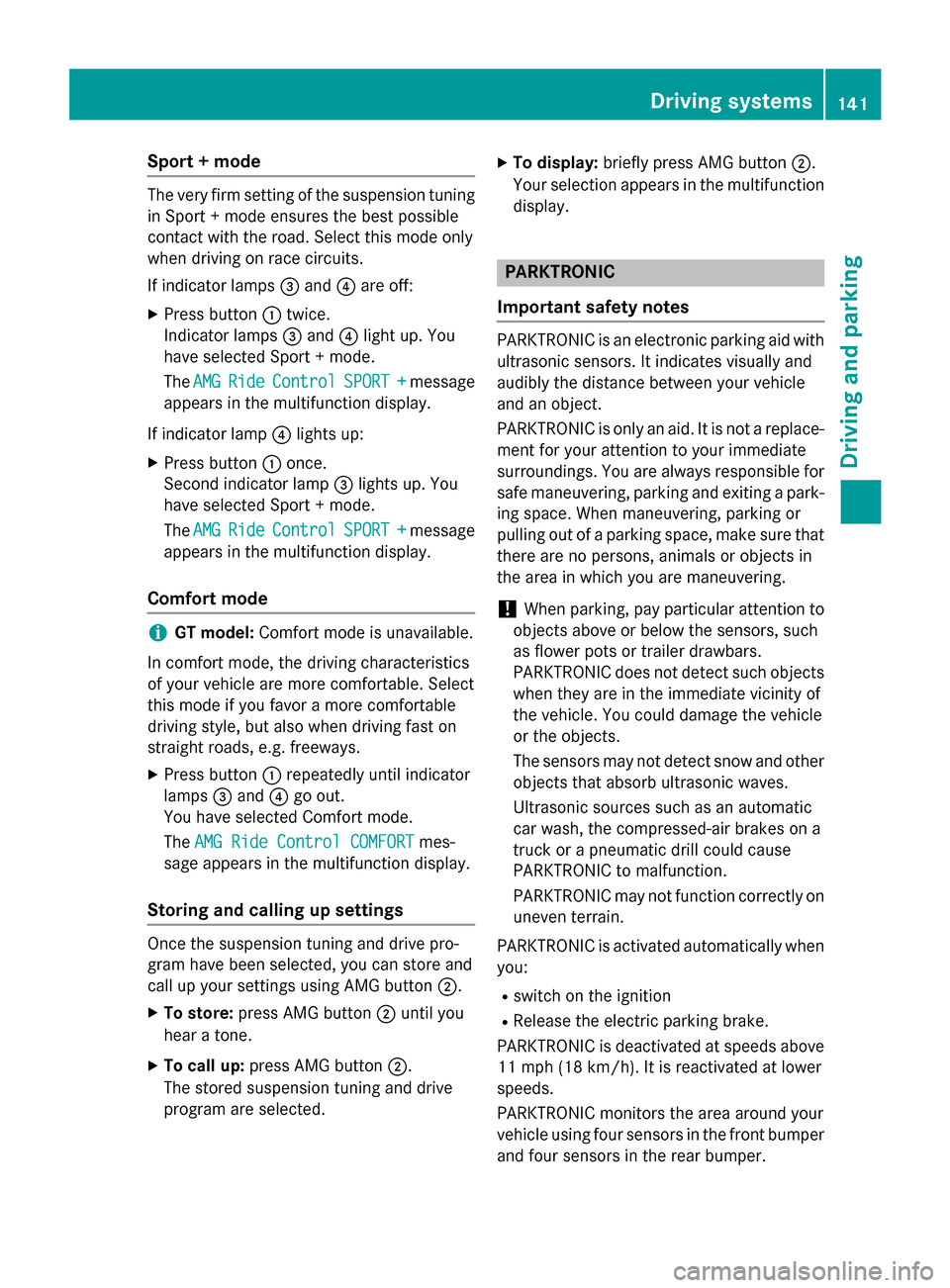
Sport
+mode The very firm settingoft
he suspension tuning
in Sport +mode ensures the best possible
contact with the road. Select this mode only
when driving on race circuits.
If indicator lamps 0087and 0085are off:
X Press button 0043twice.
Indicator lamps 0087and 0085light up. You
have selected Sport +mode.
The AMG
AMG Ride
Ride Control
Control SPORT +
SPORT +message
appears in the multifunction display.
If indicator lamp 0085lights up:
X Press button 0043once.
Secondi ndicator lamp 0087lights up. You
have selected Sport +mode.
The AMG
AMG Ride
Ride Control
Control SPORT +
SPORT +message
appears in the multifunction display.
Comfort mode i
GT model:
Comfort mode is unavailable.
In comfort mode, the driving characteristics
of your vehicle are more comfortable. Select
this mode if you favor amore comfortable
driving style, but also when driving fast on
straight roads, e.g. freeways.
X Press button 0043repeatedly until indicator
lamps 0087and 0085go out.
You have selected Comfort mode.
The AMG Ride Control COMFORT AMG Ride Control COMFORT mes-
sage appears in the multifunction display.
Storing and calling up settings Once the suspension tuning and drive pro-
gram have been selected, you can store and
call up your settings using AMG button 0044.
X To store: press AMG button 0044until you
hear atone.
X To call up: press AMG button 0044.
The stored suspension tuning and drive
program are selected. X
To display: briefly press AMG button 0044.
Your selection appears in the multifunction
display. PARKTRONIC
Important safety notes PARKTRONIC is an electronic parking aid with
ultrasonic sensors. It indicates visuallya nd
audibly the distance between your vehicle
and an object.
PARKTRONIC is only an aid. It is not areplace-
ment for your attention to your immediate
surroundings. You are always responsible for
safe maneuvering, parking and exiting apark-
ing space. When maneuvering, parking or
pulling out of aparking space, make sure that
there are no persons, animals or objectsin
the area in which you are maneuvering.
! When parking, pay particular attention to
objectsa bove or below the sensors, such
as flower pots or trailer drawbars.
PARKTRONIC does not detect such objects
when they are in the immediate vicinity of
the vehicle. You could damage the vehicle
or the objects.
The sensors may not detect snow and other
objectst hat absorb ultrasonic waves.
Ultrasonic sources such as an automatic
car wash, the compressed-air brakes on a
truck or apneumatic drill could cause
PARKTRONIC to malfunction.
PARKTRONIC may not function correctly on uneven terrain.
PARKTRONIC is activated automatically when you:
R switch on the ignition
R Release the electric parking brake.
PARKTRONIC is deactivated at speeds above
11 mph (18 km/h) .Itisreactivated at lower
speeds.
PARKTRONIC monitorst he area around your
vehicle using four sensors in the front bumper
and four sensors in the rear bumper. Driving systems
141Driving and parking Z
Page 147 of 290
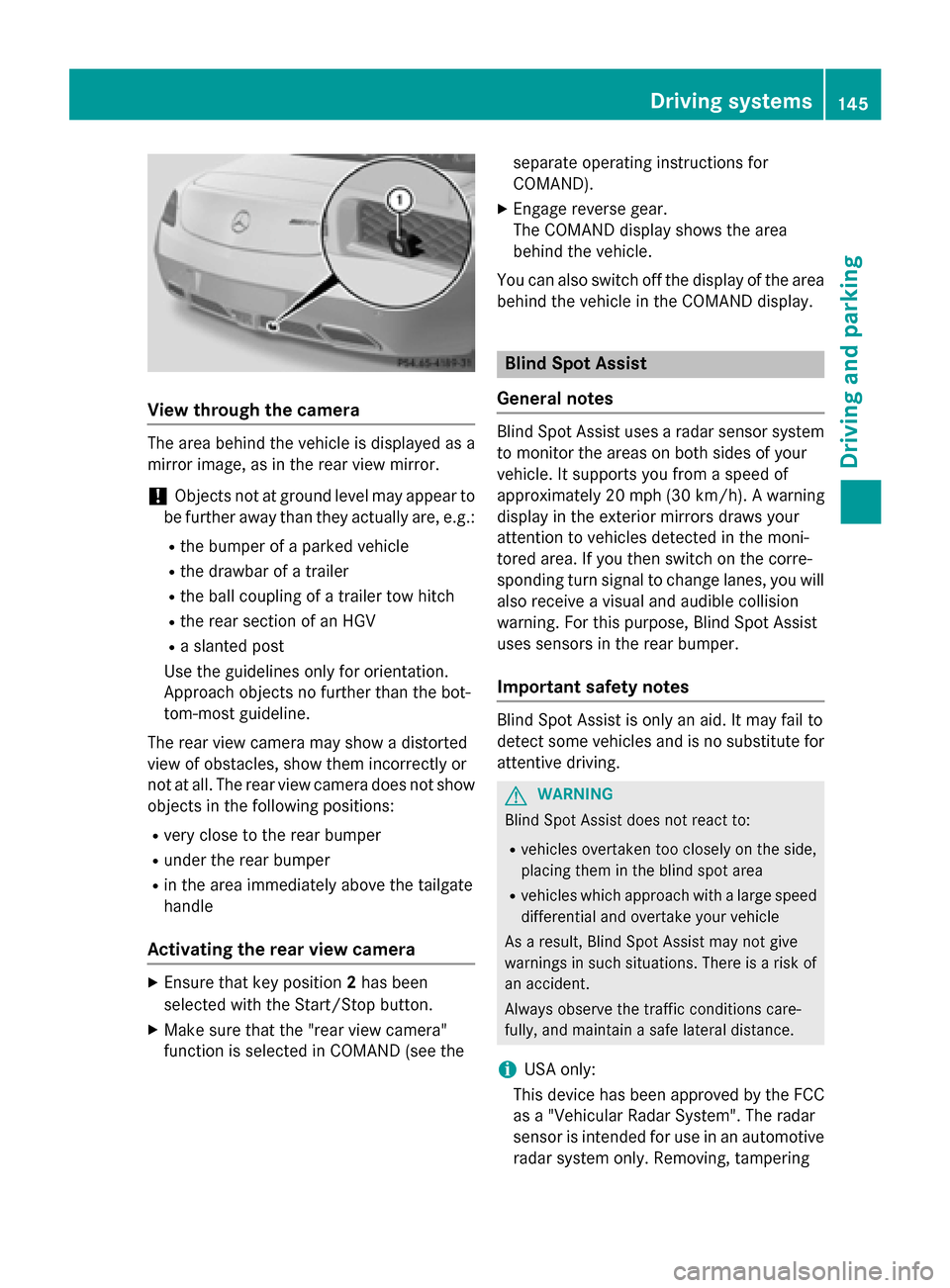
Vie
wthroug hthe camera The area behind the vehicl
eisdisplayed as a
mirror image, as in the rea rviewm irror.
! Objects not at ground level ma
yappea rto
be further away tha nthey actually are, e.g.:
R the bumpe rofaparked vehicle
R the drawbar of atrailer
R the ball coupling of atraile rtow hitch
R the rea rsection of an HGV
R as lante dpost
Use the guideline sonlyf or orientation.
Approach objects no further tha nthe bot-
tom-most guideline.
The rea rviewc amera ma yshowad istorted
vie wofo bstacles, sho wthem incorrectly or
not at all. The rea rviewc amera does not show
objects in the following positions:
R very close to the rea rbum per
R under the rea rbum per
R in the area immediatel yabove the tailgate
handle
Activatin gthe rear view camera X
Ensure tha tkey position 2ha sb een
selecte dwitht he Start/Sto pbutton.
X Make sure tha tthe "rea rviewc amera"
functio niss electe dinCOMAND (se ethe separate operating instructions for
COMAND).
X Engage reverse gear.
The COMAND display shows the area
behind the vehicle.
Yo uc an also switch off the display of the area
behind the vehicl einthe COMAND display. Blind Spo
tAssist
General notes Blind Spo
tAssist uses aradar sensor system
to monitor the area sonboths ides of your
vehicle. It supports yo ufrom aspeed of
approximatel y20m ph (30 km/h). Awarning
display in the exterio rmirrors draws your
attentio ntovehicles detected in the moni-
tore darea. If youthen switch on the corre-
sponding turn signa ltochange lanes, yo uwill
also receive avisua land audibl ecollision
warning .For thi spurpose, Blind Spo tAssist
uses sensors in the rea rbum per.
Important safety notes Blind Spo
tAssist is onl yanaid.Itm ayfailto
detect som evehicles and is no substitute for
attentive driving. G
WARNING
Blind Spo tAssist does not react to:
R vehicles overtake ntoo closel yonthe side,
placing them in the blind spo tarea
R vehicles which approach with alarge speed
differential and overtake your vehicle
As aresult, Blind Spo tAssist ma ynot give
warning sinsuchs ituations. There is ariskof
an accident.
Alway sobserve the traffic conditions care-
fully ,and maintain asafel atera ldistance.
i USA only:
Thi sd evice ha sbeena pproved by the FCC
as a"Vehicular Rada rSystem" .The radar
sensor is intende dfor us einana utomotive
rada rsystem only. Removing, tampering Driving systems
145Driving andparking Z
Page 246 of 290
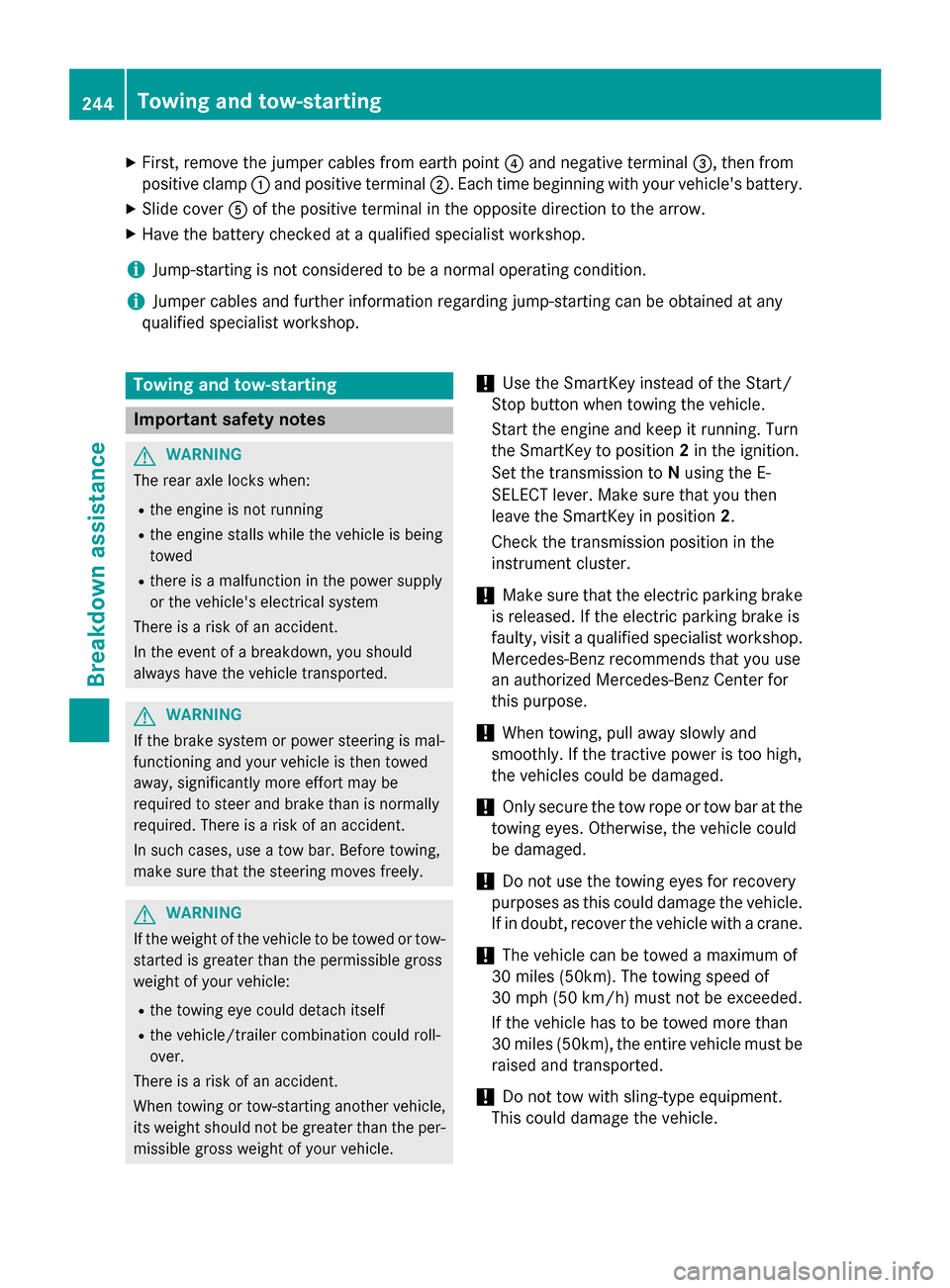
X
First, remove the jumper cable sfrom earth point 0085and negative terminal 0087,then from
positiv eclamp 0043and positiv eterminal 0044.Each time beginning with your vehicle' sbattery.
X Slide cover 0083of the positiv eterminal in the opposite directio ntothe arrow.
X Have the battery checke dataqualified specialist workshop.
i Jump-starting is not considered to be
anorma loperating condition.
i Jumpe
rcable sand further information regarding jump-starting can be obtained at any
qualified specialist workshop. Towing and tow-starting
Important safety notes
G
WARNING
The rea raxlel ocks when:
R the engine is not running
R the engine stalls while the vehicle is being
towed
R there is amalfunction in the power supply
or the vehicle' selectrica lsystem
There is ariskofana ccident.
In the event of abreakdown, yo ushould
always hav ethe vehicle transported. G
WARNING
If the brake system or power steering is mal-
functioning and your vehicle is then towed
away ,significantly more effort may be
required to stee rand brake than is normally
required .There is ariskofana ccident.
In such cases, use atow bar. Befor etowing,
make sur ethat the steering move sfreely. G
WARNING
If the weigh tofthe vehicle to be towe dortow-
starte disgreater than the permissible gross
weigh tofyourv ehicle:
R the towing ey ecould detach itself
R the vehicle/trailer combinatio ncould roll-
over.
There is ariskofana ccident.
Whe ntowing or tow-starting another vehicle,
its weigh tshoul dnot be greater than the per-
missible gros sweigh tofy ourv ehicle. !
Use the SmartKe
yinstead of the Start/
Stop button whe ntowing the vehicle.
Start the engine and keep it running. Turn
the SmartKe ytoposition 2in the ignition.
Set the transmission to Nusing the E-
SELECT lever. Make sure that yo uthen
leave the SmartKe yinposition 2.
Check the transmission positio ninthe
instrument cluster.
! Make sure that the electric parking brake
is released .Ifthe electric parking brake is
faulty ,visit aquali fied specialist workshop.
Mercedes-Benz recommends that yo uuse
an authorized Mercedes-Benz Center for
this purpose.
! Whe
ntowing, pull away slowl yand
smoothly .Ifthe tractive power is too high,
the vehicles could be damaged.
! Only secure the tow rope or tow ba
ratthe
towing eyes. Otherwise, the vehicle could
be damaged.
! Do not us
ethe towing eyes for recovery
purposes as this could damag ethe vehicle.
If in doubt, recover the vehicle with acrane.
! The vehicle can be towe
damaximum of
30 miles (50km). The towing speed of
30 mph (50 km/h )mustn ot be exceeded.
If the vehicle ha stobetowedmore than
30 miles (50km), the entire vehicle mus tbe
raised and transported.
! Do not tow with sling-typ
eequipment.
Thi scould damag ethe vehicle. 244
Towinga
nd tow-startingBreakdow nassistance
Page 262 of 290
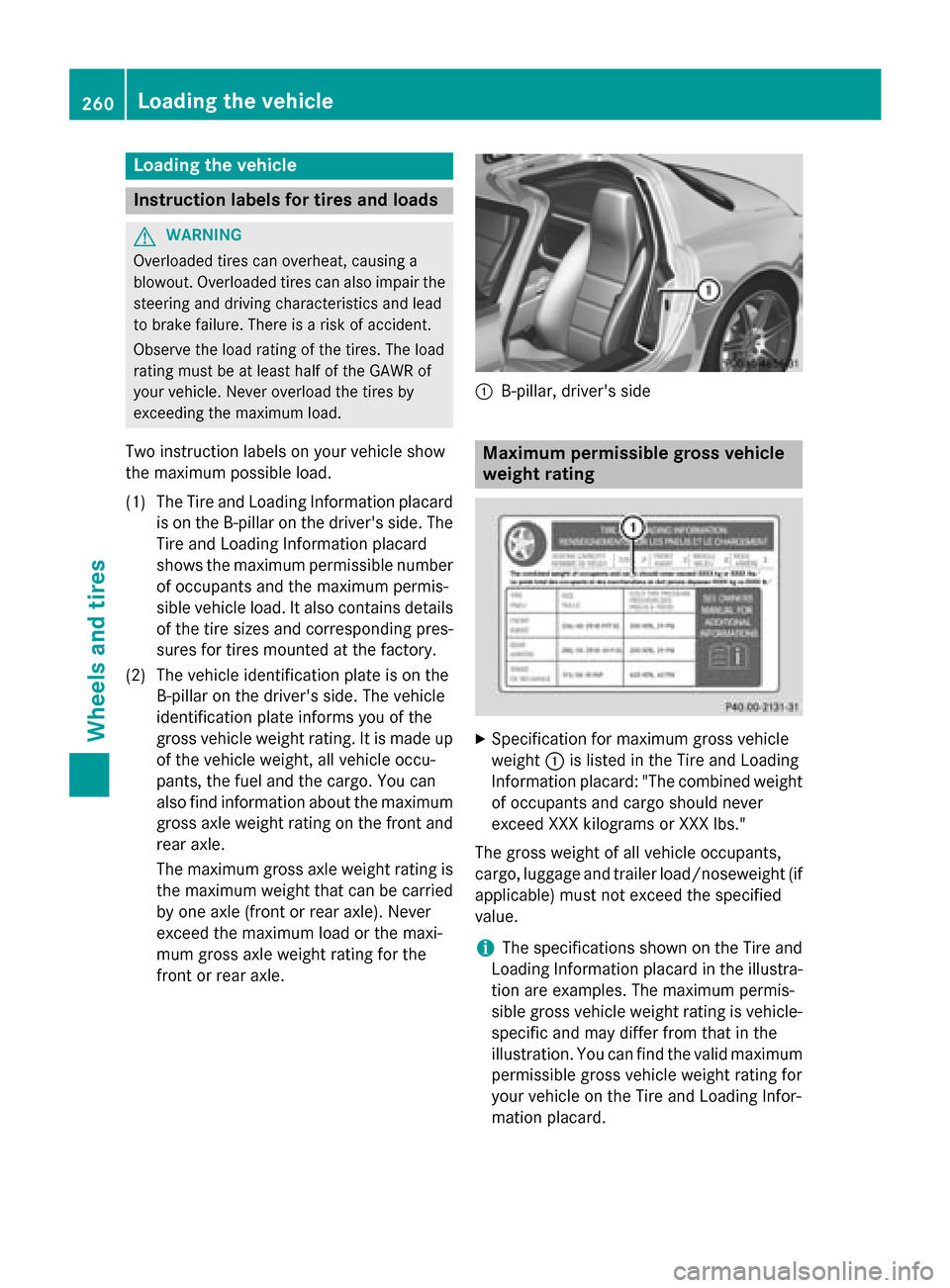
Loading th
evehicle Instruction labels for tires and loads
G
WARNING
Overloade dtires can overheat ,causing a
blowout .Overloade dtires can also impair the
steerin gand driving characteristic sand lead
to brak efailure. Ther eisarisk of accident.
Observe th eload rating of th etires. The load
rating must be at least half of th eGAWR of
your vehicle .Never overload th etires by
exceedin gthe maximum load.
Two instruction labels on your vehicle show
th em aximum possible load.
(1) The Tire and Loadin gInformation placard
is on th eB-pillar on th edriver' sside. The
Tire and Loadin gInformation placard
shows th emaximum permissibl enumber
of occupant sand th emaximum permis-
sible vehicle load. It also contain sdetails
of th etires izes and corresponding pres-
sures for tires mounte datthefactory.
(2) The vehicle identification plat eisonthe
B-pillar on th edriver' sside. The vehicle
identification plat einform syou of the
gross vehicle weight rating .Itismade up
of th evehicle weight ,all vehicle occu-
pants, th efuel and th ecargo. You can
also fin dinformatio nabout th emaximum
gross axle weight rating on th efront and
rear axle.
The maximum gross axle weight rating is th em aximum weight that can be carried
by on eaxle (fron torrear axle) .Never
exceed th emaximum load or th emaxi-
mum gross axle weight rating for the
fron torr ear axle. 0043
B-pillar ,driver' sside Maximum permissible gros
svehicle
weight rating X
Specification for maximum gross vehicle
weight 0043is listed in th eTire and Loading
Information placard: "The combine dweight
of occupant sand cargo should never
exceed XXX kilogram sorXXX lbs."
The gross weight of all vehicle occupants,
cargo, luggage and trailer load/noseweight (if
applicable) must no texceed th especified
value.
i The specifications shown on th
eTire and
Loadin gInformation placar dintheillustra-
tio na re examples. The maximum permis-
sible gross vehicle weight rating is vehicle-
specific and may differ from that in the
illustration .You can fin dthe valid maximum
permissibl egross vehicle weight rating for
your vehicle on th eTire and Loadin gInfor-
mation placard. 260
Loading th
evehicleWheels and tires
Page 264 of 290
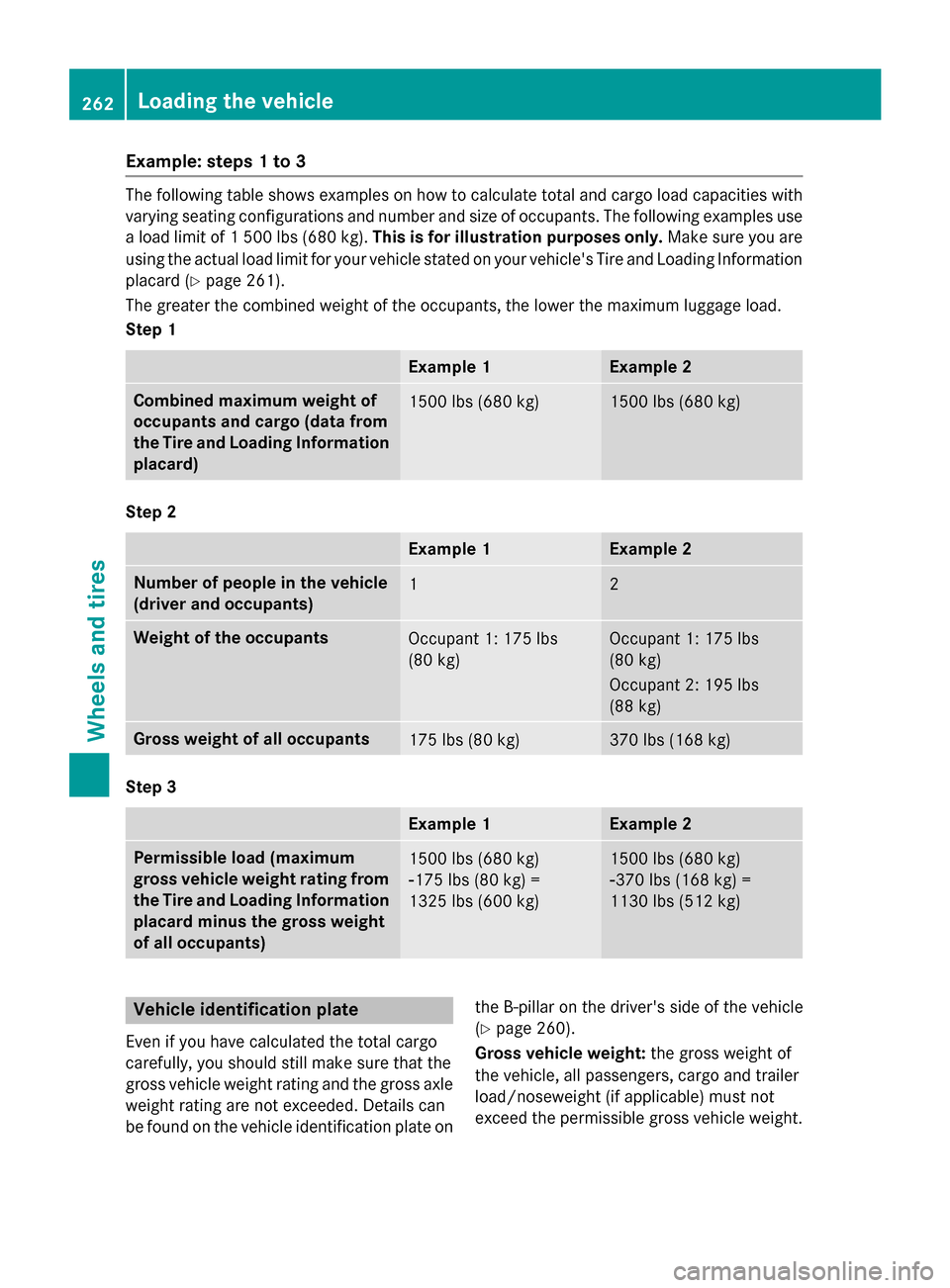
Example: steps
1to3The followin
gtable show sexamples on how to calculate total and cargo load capacities with
varying seating configurations and number and siz eofoccupants. The followin gexamples use
al oad limit of 1500lbs (68 0kg). This is for illustration purposes only. Makesure you are
usin gthe actual load limit for your vehicle state donyour vehicle's Tire and Loading Information
placar d(Ypage 261).
The greate rthe combined weight of th eoccupants, th elower th emaximum luggage load.
Step 1 Example 1 Example 2
Combined maximum weight of
occupant
sand cargo (data from
th eT irea nd Loading Information
placard) 1500 lbs (68
0kg) 1500 lbs (68
0kg) Step 2
Example 1 Example 2
Number of people in th
evehicle
(driver and occupants) 1 2
Weigh
toftheoccupants Occupan
t1:175lbs
(80 kg) Occupan
t1:175lbs
(80 kg)
Occupan t2:195lbs
(88 kg) Gross weight of all occupants
17
5lbs (80 kg) 37
0lbs (16 8kg) Step 3
Example 1 Example 2
Permissible load (maximum
gross vehicle weight ratin
gfrom
th eT irea nd Loading Information
placar dminus th egross weight
of all occupants) 1500 lbs (68
0kg)
00F817 5lbs (80 kg) =
1325 lbs (60 0kg) 1500 lbs (68
0kg)
00F837 0lbs (16 8kg) =
1130 lbs (51 2kg) Vehicle identification plate
Even if you have calculate dthe total cargo
carefully, you shoul dstill mak esure that the
gross vehicle weight rating and th egross axle
weight rating are no texceeded .Detail sc an
be foun donthevehicle identification plat eonth
eB -pillar on th edriver' sside of th evehicle
(Y page 260).
Gross vehicle weight: theg ross weight of
th ev ehicle ,all passengers ,cargo and trailer
load/noseweight (if applicable) must not
exceed th epermissible gross vehicle weight. 262
Loading th
evehicleWheels and tires